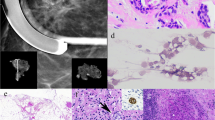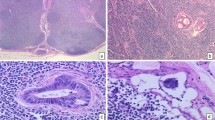Abstract
Lymph node dissection plays an important role in staging and treatment of solid cancers. Sentinel node biopsy (SNB) has been introduced to minimize the extent of surgery and to enable assessment of minimal residual disease (MRD) without compromising accurate staging or survival. This review addresses the variation in technical aspects and outcome of SNB and MRD assessment in patients with breast and gastrointestinal cancer. Quality control leading to standardization of SNB and pathological examination will enable reliable comparison of studies, which is necessary for consensus of diagnostic and therapeutic strategies.
Similar content being viewed by others
References
Tepper JE, O'Connell MJ, Niedzwiecki D, et al. Impact of number of nodes retrieved on outcome in patients with rectal cancer.J Clin Oncol 2001;19:157–63.
Camp RL, Rimm EB, Rimm DL. A high number of tumor free axillary lymph nodes from patients with lymph node negative breast carcinoma is associated with poor outcome.Cancer 2000; 88:108–13.
Le Voyer TE, Sigurdson ER, Hanlon AL, et al. Colon cancer survival is associated with increasing number of lymph nodes analyzed: a secondary survey of intergroup trial INT-0089.J Clin Oncol 2003;21:2912–9.
Herr HW, Bochner BH, Dalbagni G, et al. Impact of the number of lymph nodes retrieved on outcome in patients with muscle invasive bladder cancer.J Urol 2002;167:1295–8.
Overgaard M, Hansen PS, Overgaard J, et al. Postoperative radiotherapy in high-risk premenopausal women with breast cancer who receive adjuvant chemotherapy. Danish Breast Cancer Cooperative Group 82b Trial.N Engl J Med 1997;337:949–55.
Wong SL, Edwards MJ, Chao C, et al. Sentinel lymph node biopsy for breast cancer: impact of the number of sentinel nodes removed on the false-negative rate.J Am Coll Surg 2001;192:684–9.
Dowlatshahi K, Fan M, Snider HC, et al. Lymph node micrometastases from breast carcinoma: reviewing the dilemma.Cancer 1997;80:1188–97.
Noguchi M. Therapeutic relevance of breast cancer micrometastases in sentinel lymph nodes.Br J Surg 2002;89:1505–15.
Dowlatshahi K, Fan M, Bloom KJ, et al. Occult metastases in the sentinel lymph nodes of patients with early stage breast carcinoma: a preliminary study.Cancer 1999;86:990–6.
Giuliano AE, Kirgan DM, Guenther JM, et al. Lymphatic mapping and sentinel lymphadenectomy for breast cancer.Ann Surg 1994; 220:391–8.
Cody HS III. Sentinel lymph node mapping in breast cancer.Oncology (Huntingt) 1999;13:25–34.
Schwartz GF, Giuliano AE, Veronesi U. Proceedings of the consensus conference on the role of sentinel lymph node biopsy in carcinoma of the breast, April 19–22, 2001, Philadelphia, Pennsylvania.Cancer 2002;94:2542–51.
Sasako M, McCulloch P, Kinoshita T, et al. New method to evaluate the therapeutic value of lymph node dissection for gastric cancer.Br J Surg 1995;82:346–51.
CJH van de Velde, KCMJ Peeters. The gastric cancer treatment controversy.J Clin Oncol 2003;21:2234–6.
Bonenkamp JJ, Songun I, Hermans J, et al. Randomised comparison of morbidity after D1 and D2 dissection for gastric cancer in 996 Dutch patients.Lancet 1995;345:745–8.
Cuschieri A, Fayers P, Fielding J, et al. Postoperative morbidity and mortality after D1 and D2 resections for gastric cancer: preliminary results of the MRC randomised controlled surgical trial. The Surgical Cooperative Group.Lancet 1996;347:995–9.
Aikou T, Higashi H, Natsugoe S, et al. Can sentinel node navigation surgery reduce the extent of lymph node dissection in gastric cancer?Ann Surg Oncol 2001;8:90S-3S.
Noguchi S, Hiratsuka M, Furukawa H, et al. Detection of gastric cancer micrometastases in lymph nodes by amplification of keratin 19 mRNA with reverse transcriptase-polymerase chain reaction.Jpn J Cancer Res 1996;87:650–4.
Liefers GJ, Cleton-Jansen, AM, van de Velde CJ, et al. Micrometastases and survival in stage II colorectal cancer [see comments].N Engl J Med 1998;339:223–8.
Mori M, Mimori K, Ueo H, et al. Clinical significance of molecular detection of carcinoma cells in lymph nodes and peripheral blood by reverse transcription-polymerase chain reaction in patients with gastrointestinal or breast carcinomas.J Clin Oncol 1998;16:128–32.
Rosenberg R, Hoos A, Mueller J, et al. Prognostic significance of cytokeratin-20 reverse transcriptase polymerase chain reaction in lymph nodes of node-negative colorectal cancer patients.J Clin Oncol 2002;20:1049–55.
Noura S, Yamamoto H, Ohnishi T, et al. Comparative detection of lymph node micrometastases of stage II colorectal cancer by reverse transcriptase polymerase chain reaction and immunohistochemistry.J Clin Oncol 2002;20:4232–41.
Tsavellas G, Patel H, Allen-Mersh TG. Detection and clinical significance of occult tumor cells in colorectal cancer.Br J Surg 2001;88:1307–20.
Cutait R, Alves VA, Lopes LC, et al. Restaging of colorectal cancer based on the identification of lymph node micrometastases through immunoperoxidase staining of CEA and cytokeratins.Dis Colon Rectum 1991;34:917–20.
Jeffers MD, O'Dowd GM, Mulcahy H, et al. The prognostic significance of immunohistochemically detected lymph node micrometastases in colorectal carcinoma.J Pathol 1994;172:183–7.
Greenson JK, Isenhart CE, Rice R, et al. Identification of occult micrometastases in pericolic lymph nodes of Duke's B colorectal cancer patients using monoclonal antibodies against cytokeratin and CC49. Correlation with long-term survival.Cancer 1994;73:563–9.
Adell G, Boeryd B, Franlund B, et al. Occurrence and prognostic importance of micrometastases in regional lymph nodes in Dukes' B colorectal carcinoma: an immunohistochemical study.Eur J Surg 1996;162:637–42.
Broll R, Schauer V, Schimmelpenning H, et al. Prognostic relevance of occult tumor cells in lymph nodes of colorectal carcinomas: an immunohistochemical study.Dis Colon Rectum 1997;40:1465–71.
Sasaki M, Watanabe H, Jass JR, et al. Occult lymph node metastases detected by cytokeratin immunohistochemistry predict recurrence in “node-negative” colorectal cancer.J Gastroenterol 1997; 32:758–64.
Oberg A, Stenling R, Tavelin B, et al. Are lymph node microme-tastases of any clinical significance in Dukes Stages A and B colorectal cancer?Dis Colon Rectum 1998;41:1244–9.
Yasuda K, Adachi Y, Shiraishi N, et al. Pattern of lymph node micrometastasis and prognosis of patients with colorectal cancer.Ann Surg Oncol 2001;8:300–4.
Choi HJ, Choi YY, Hong SH. Incidence and prognostic implications of isolated tumor cells in lymph nodes from patients with Dukes B colorectal carcinoma.Dis Colon Rectum 2002;45:750–5.
Wood TF, Tsioulias GJ, Morton DL, et al. Focused examination of sentinel lymph nodes upstages early colorectal carcinoma.Am Surg 2000;66:998–1003.
Tsioulias GJ, Wood TF, Morton DL, et al. Lymphatic mapping and focused analysis of sentinel lymph nodes upstage gastrointestinal neoplasms.Arch Surg 2000;135:926–32.
Kitagawa Y, Watanabe M, Hasegawa H, et al. Sentinel node mapping for colorectal cancer with radioactive tracer.Dis Colon Rectum 2002;45:1476–1480.
Nwariaku FE, Euhus DM, Beitsch PD, et al. Sentinel lymph node biopsy, an alternative to elective axillary dissection for breast cancer.Am J Surg 1998;176:529–31.
Borgstein PJ, Pijpers R, Comans EF, et al. Sentinel lymph node biopsy in breast cancer: guidelines and pitfalls of lymphoscintigraphy and gamma probe detection.J Am Coll Surg 1998;186:275–83.
Krag D, Weaver D, Ashikaga T, et al. The sentinel node in breast cancer—a multicenter validation study.N Engl J Med 1998;339:941–6.
Hill AD, Mann GB, Borgen PI, et al. Sentinel lymphatic mapping in breast cancer.J Am Coll Surg 1999;188:545–9.
Veronesi U, Paganelli G, Viale G, et al. Sentinel lymph node biopsy and axillary dissection in breast cancer: results in a large series.J Natl Cancer Inst 1999;91:368–73.
Winchester DJ, Sener SF, Winchester DP, et al. Sentinel lymphadenectomy for breast cancer: experience with 180 consecutive patients: efficacy of filtered technetium 99m sulphur colloid with overnight migration time.J Am Coll Surg 1999;188:597–603.
Bass SS, Cox CE, Ku NN, et al. The role of sentinel lymph node biopsy in breast cancer.J Am Coll Surg 1999;189:183–94.
Morrow M, Rademaker AW, Bethke KP, et al. Learning sentinel node biopsy: results of a prospective randomized trial of two techniques.Surgery 1999;126:714–20.
Fraile M, Rull M, Julian FJ, et al. Sentinel node biopsy as a practical alternative to axillary lymph node dissection in breast cancer patients: an approach to its validity.Ann Oncol 2000;11:701–5.
Kollias J, Gill PG, Chatterton BE, et al. Reliability of sentinel node status in predicting axillary lymph node involvement in breast cancer.Med J Aust 1999;171:461–5.
Tafra L. The learning curve and sentinel node biopsy.Am J Surg 2001;182:347–50.
Nano MT, Kollias J, Farshid G, et al. Clinical impact of falsenegative sentinel node biopsy in primary breast cancer.Br J Surg 2002;89:1430–4.
Hiratsuka M, Miyashiro I, Ishikawa O, et al. Application of sentinel node biopsy to gastric cancer surgery.Surgery 2001;129:335–40.
Yasuda S, Shimada H, Ogoshi K, et al. Preliminary study for sentinel lymph node identification with Tc-99m tin colloid in patients with esophageal or gastric cancer.Tokai J Exp Clin Med 2001;26:15–8.
Ichikura T, Morita D, Uchida T, et al. Sentinel node concept in gastric carcinoma.World J Surg 2002;26:318–22.
Kitagawa Y, Fujii H, Mukai M, et al. Radio-guided sentinel node detection for gastric cancer.Br J Surg 2002;89:604–8.
Miwa K, Kinami S, Taniguchi K, et al. Mapping sentinel nodes in patients with early-stage gastric carcinoma.Br J Surg 2003;90:178–82.
Maehara Y, Oshiro T, Endo K, et al. Clinical significance of occult micrometastasis lymph nodes from patients with early gastric cancer who died of recurrence.Surgery 1996;119:397–402.
Cai J, Ikeguchi M, Maeta M, et al. Micrometastasis in lymph nodes and microinvasion of the muscularis propria in primary lesions of submucosal gastric cancer.Surgery 2000;127:32–9.
Morgagni P, Saragoni L, Folli S, et al. Lymph node micrometastases in patients with early gastric cancer: experience with 139 patients.Ann Surg Oncol 2001;8:170–4.
Fukagawa T, Sasako M, Mann GB, et al. Immunohistochemically detected micrometastases of the lymph nodes in patients with gastric carcionma.Cancer 2001;92:753–60.
Lee E, Chae Y, Kim I, et al. Prognostic relevance of immunohistochemically detected lymph node micrometastasis in patients with gastric carcinoma.Cancer 2002;94:2867–73.
Joosten JJ, Strobbe LJ, Wauters CA, et al. Intraoperative lymphatic mapping and the sentinel node concept in colorectal carcinoma.Br J Surg 1999;86:482–6.
Wiese DA, Saha S, Badin J, et al. Pathologic evaluation of sentinel lymph nodes in colorectal carcinoma.Arch Pathol Lab Med 2000; 124:1759–63.
Feig BW, Curley S, Lucci A, et al. A caution regarding lymphatic mapping in patients with colon cancer.Am J Surg 2001;182:707–12.
Wong JH, Steineman S, Calderia C, et al. Ex vivo sentinel node mapping in carcinoma of the colon and rectum.Ann Surg 2001; 233:515–21.
Saha S, Bilchik A, Wiese D, et al. Ultrastaging of colorectal cancer by sentinel lymph node mapping technique—a multicenter trial.Ann Surg Oncol 2001;8:94S-8S.
Merrie AE, van Rij AM, Phillips LV, et al. Diagnostic use of the sentinel node in colon cancer.Dis Colon Rectum 2001;44:410–7.
Esser S, Reilly WT, Riley LB, et al. The role of sentinel lymph node mapping in staging of colon and rectal cancer.Dis Colon Rectum 2001;44:850–4.
Broderick-Villa G, Ko A, O'Connell TX, et al. Does tumor burden limit the accuracy of lymphatic mapping and sentinel lymph node biopsy in colorectal cancer?Cancer J 2002;8:445–50.
Wood TF, Nora DT, Morton DL, et al. One hundred consecutive cases of sentinel lymph node mapping in early colorectal carcinoma: detection of missed micrometastases.J Gastrointest Surg 2002;6:322–9.
Bilchik AJ, Nora D, Tollenaar RA, et al. Ultrastaging of early colon cancer using lymphatic mapping and molecular analysis.Eur J Cancer 2002;38:977–85.
Fitzgerald TL, Khalifa MA, Al Zahrani M, et al. Ex vivo sentinel lymph node biopsy in colorectal cancer: a feasibility study.J Surg Oncol 2002;80:27–32.
Paramo JC, Summerall J, Poppiti R, et al. Validation of sentinel node mapping in patients with colon cancer.Ann Surg Oncol 2002;9:550–4.
Author information
Authors and Affiliations
Corresponding author
Rights and permissions
About this article
Cite this article
Doekhie, F.S., Peeters, K.C.M.J., Tollenaar, R.A.E.M. et al. Minimal residual disease assessment in sentinel nodes of breast and gastrointestinal cancer: A plea for standardization. Annals of Surgical Oncology 11 (Suppl 3), 236S–241S (2004). https://doi.org/10.1007/BF02523636
Received:
Accepted:
Issue Date:
DOI: https://doi.org/10.1007/BF02523636




